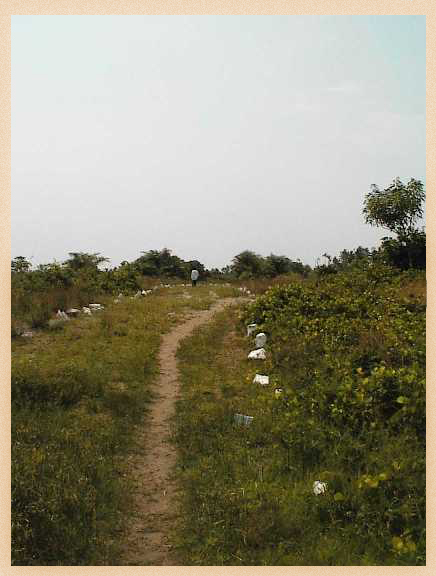 |
From Freedom to Freedom Trail Project
Every year during the month of February in the United States, we celebrate the long journey to freedom. We retell the story of forced journeys across the Atlantic Ocean, and only imagine the kind of emotions that surged through the veins of the enslaved Africans as they passed through the Middle Passage experience. We “Lift Every Voice and Sing” the song of liberty. We use the verse that talks about the road watered with blood as a gruesome reminder of the floggings, lynching, and other atrocities our ancestors endured in the Antebellum South and pre-Civil Rights America. The sentence “Thank God Almighty, we are free at last,” reminds us that slavery was not their destination; that they always had their eyes on freedom. Today, the freedom that was their goal has become our heritage. But our freedom is not complete until we reach the state of freedom that was before the Atlantic slave trade began. Therefore, from February 2010, as a part of the African American History Month celebration, we shall be marching from Freedom to Freedom. We shall be marching from Freedom to Freedom through a trail that follows Underground Railroad sites in the United States and Tunnels of Disappearance in Nigeria to one of the very beginnings of Igbo slave journeys.
Thousands of the Igbo victims of the Atlantic slave trade came from the hinterland. They were not declared slaves until they were ritually processed, symbolically declared dead, and covertly funneled through cave tunnels to coastal towns of Bonny, Calabar, and Brass for the forced journey across the Atlantic Ocean. Most of those that traveled from Bonny went directly to Virginia and from there to the plantations in the Deep South—part of Georgia, all of Alabama and Mississippi. From the Deep South, with their eyes set on freedom, thousands of the enslaved Africans escaped to freedom in the North even to Canada.
The trail will lead to an ancient Cave Temple Complex in Arochukwu, Nigeria. In pre-Atlantic slavery times, the people of Arochukwu (the Aro) had performed customary rites for Chukwu—the Great Spirit—in the Temple Complex. As the ritual specialists and custodians of the Temple the Aro alone could enter the cave and into the Dark Chamber Presence of Chukwu, and through a major Oracle (Ibin Ukpabi) interpret the voice of Chukwu. At that time, the Ancient Cave Temple Complex was the highest court of justice in Igboland. People from all over Igboland went to the Temple to seek the truth from Chukwu Abiamara (“the Great Spirit to which Seekers of the Truth Come”) and to hear judgments through the Oracle. Those found guilty were either sold on to slavery or put to death depending upon the degree of their offence and the judgments of Chukwu. The blood of those that received the death penalty colored the running stream in the cave, the River of Blood, red. At the cave entrance from which the River of Blood issued, families thus waited to receive judgment on the fate of the accused by the subsequent coloring, or not, of this stream.
It was with the advent of the Atlantic slave trade in West Africa during the 17 th century that the Aro, assuming the role of the leaders of the trade in the Igbo hinterland, exploited the Temple Complex in a very remarkable way—by using it as a major secret slave dealing location. During this time, the Aro took captured victims to the Temple Complex in what appeared to be the same ritual that had been undertaken since before memory, but as the victims disappeared into the cave tunnels (the tunnels of disappearance), the Aro would falsely color the river red with dye from the red cam wood to leave the impression that the condemned had died. The red water flowing from the cave was a signal to the relatives that the victims were dead.
In reality, some of the tunnels (the Tunnel of Disappearance) led to various exist points on the trade routes to the coastal towns of Calabar and Bonny. One of the outlets eventually led to Iyi Eke; a point from where the enslaved, now blindfolded, were led to Onu Asu Bekee, or European Beach in Ito. And from there, waiting boats took the slaves to Calabar for onward transmission to the New World and slavery. Another outlet led to Afia Oso Nwamkpi a slave market in Ututu from where, using He-Goat as a metaphor, Aro traders and escorts took the victims to major hinterland slave markets in Bende, Uzuakoli, and Azumini—Before the Middle Passage.
The Freedom to Freedom pilgrims will go through the Azumini to Arochukwu hinterland trail in Nigeria. It is a trail of pain. The idea of slave dealing in the Temple of God with direct links to Shipping Ports in the Slave Coast is painful. Entering the Chamber Presence and facing the exact place to which the slave dealers took the victims of the Atlantic slave trade for judgment and ritual processing; to the exact place where probably thousands of African slaves entered and symbolically died is breathtaking. Following the tunnels of disappearance through the trade routes to the point where the Atlantic Oceans ends in a twilight zone is heartrending. The experience can be overwhelming and the story bitter. But it is the truth. It is the truth that must told in order to begin to make real the reconnection with Africa, enhance reconciliation and forgiveness, and start the healing of the deep-seated wounds of the Atlantic slave trade and slavery on both sides of the Atlantic.
|


